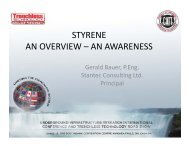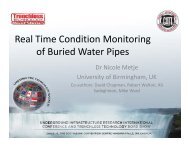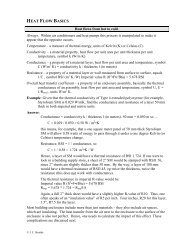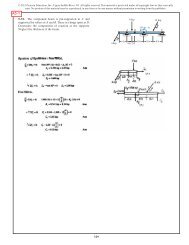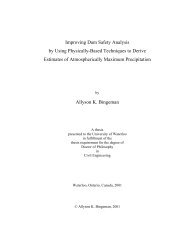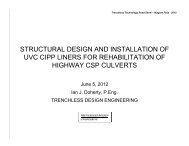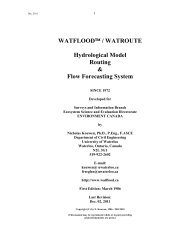Planning Horizontal Directional Drilling for Pipeline Construction
Planning Horizontal Directional Drilling for Pipeline Construction
Planning Horizontal Directional Drilling for Pipeline Construction
Create successful ePaper yourself
Turn your PDF publications into a flip-book with our unique Google optimized e-Paper software.
Anticipated ground and site access conditions will determine the type of drill rig<br />
to be employed. Typically, bore holes are completed using a truck-mounted or<br />
track-mounted rig capable of drilling the soil and bedrock materials expected at<br />
the site. As noted, where ground access into the proposed bore hole locations is<br />
not available, helicopter-transportable drilling equipment may have to be used.<br />
For some bedrock investigations, diamond coring equipment can be utilized. The<br />
scope of the drilling program, in terms of number of bore holes and depths, will<br />
depend on the length of the HDD, projected length of the design drill path and the<br />
anticipated complexity of subsurface conditions. The bore hole locations should<br />
be chosen to minimize the risk of interception by the HDD and subsequent<br />
inadvertent returns following the bore hole to the surface.<br />
The soil and bedrock strata being penetrated are logged from cuttings returned to<br />
the surface during drilling, samples from standard penetration tests (SPT), spoon<br />
and Shelby tubes, as available, and observations of drill per<strong>for</strong>mance. If soil<br />
conditions are suitable, cone penetration tests may also be carried out.<br />
Groundwater levels may be documented either by installing and monitoring<br />
piezometers or based on observations of groundwater seepages during and after<br />
drilling.<br />
In addition to logging and characterizing the subsurface materials and<br />
groundwater conditions, the field investigation should focus on identifying<br />
conditions that could impact the feasibility of designing and constructing an<br />
HDD, including:<br />
• the distribution/characteristics of surficial overburden deposits, in particular<br />
the occurrence of cohesionless clean silt-sand deposits and distribution and<br />
characteristics of any coarse-textured granular layers (i.e., gravel, cobbles or<br />
boulders);<br />
• depths to and nature of the bedrock <strong>for</strong>mations, including the presence of hard<br />
and/or abrasive units (that could delay the project or impacts rates of wear on<br />
drilling equipment); and<br />
• the presence of discontinuities, joints, fractures and fissures, that could<br />
contribute to instability of the bore during drilling and/or provide a path to the<br />
surface <strong>for</strong> drilling fluids.<br />
6.2.4 Geophysical Surveys<br />
When the results of bore hole investigations are inclusive or incomplete, use of<br />
shallow geophysical techniques may be considered. Seismic surveys, ground<br />
penetrating radar (GPR), electromagnetic (EM) surveys and electrical resistivity<br />
tomography (ERT) can be employed, often in combination. The application of<br />
geophysical methods is affected by the soil/bedrock conditions at the site and<br />
some techniques may not be appropriate in all situations.<br />
Depending onsite conditions and expected subsurface materials, geophysical<br />
techniques can be used to supplement the bore hole investigation results.<br />
However, use of geophysical techniques as a substitute <strong>for</strong>, rather than as a<br />
September 2004 <strong>Planning</strong> <strong>Horizontal</strong> <strong>Directional</strong> <strong>Drilling</strong> <strong>for</strong> <strong>Pipeline</strong> <strong>Construction</strong> Page 6-5



